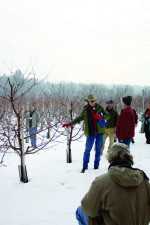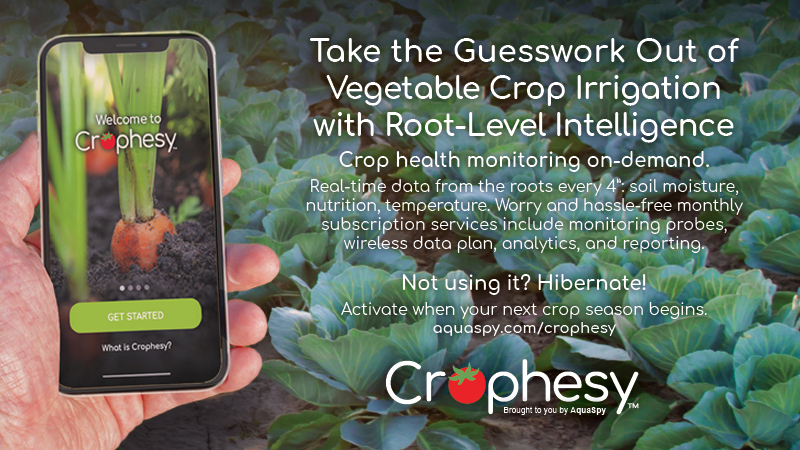IFTA Conference Focuses On Innovation In The Tree Fruit Industry

Innovation was the theme of the 56th Annual International Fruit Tree Association Conference held Feb. 23-Feb. 27 in Boston, MA. The over-arching theme of innovation through technology was presented in several categories including innovation in production, automation, varieties, and climate change strategies.
Innovation in Automation
A harvest assist system from DBR Conveyor Concepts was presented on Feb. 25. Michigan’s Phil Brown (of Phil Brown Welding), Mike Rasch, and Chuck Dietrich developed the mechanized platform for apple harvesting.
What began as a project to address labor issues with harvesting, starting with a single hose on a Phil Brown Welding Brownie, gradually evolved to a double hose on a Brownie with a box shuttle. The advantages of the harvest assist system are increased safety, efficiency, fruit quality, field sorting, local harvesting at the tops of trees, and the system will also allow for two packing shifts a day.
A vacuum-based dry bin filling machine is one of the latest advancements with the project. The filling machine allows for four workers picking on the ground or platform, with remote steering.
A tractor-pulled harvest assist system was used in Washington and a system fitted to an orchard platform was used in Pennsylvania. The machine was tested in Washington on apples and in California on peaches and pears.
“Positioning with equipment is key, as is tree form,” said Karen Lewis of Washington State University.
Jim Schupp of Penn State University noted the challenge of replacing humans at apple picking. With the DBR, workers show less fatigue, especially with non-harvesting tasks in between pickings, which may expand the labor pool.
Schupp also conducted studies on the bruising of apples when using the harvesting machine. Schupp noted that apple quality was downgraded because of bruising, but the shape of the apple determines the bruising of the apple in the harvest assist system.
“Bruising was noted in the vacuum when the fruit was over-mature,” Schupp said. He noted that it was not related to firmness, starch index, and fruit size.
Paul Heinemann of Penn State University said his team studied the effect of gravity on apple travel speed, and did a detailed assessment of apple deceleration and distribution. What they found was that there was a need for speed sensors to determine apple size and vacuum tube size, there is a need to adjust the decelerator and elephant ear conveyor rotating, and vacuum pumps should be individually controlled.
Heinemann noted that ergonomics of the harvest assist system will be examined in the future.
Keeping with the innovation in automation theme, Dr. Sanjiv Singh of Carnegie Mellon University presented an autonomous prime mover (APM). The APM is a remote-controlled vehicle that can be operated remotely to maneuver up and down orchard rows. Workers, generally on a platform, are able to control the APM’s speed, and lasers help pinpoint the vehicles’ steering.
Singh highlighted several concerns for growers in the field, including “returns limited by labor availability, cost, and seasonality.”
He sees the advantages of the APM with its “low cost, and the ability to multi-task.” Vehicles that a grower already has on hand can be modified to become an APM.
“[The autonomous prime mover can be used when] applying wire, green fruit thinning, apple training, and pheromone application,” said Singh. “… Many tasks [in the orchard] involve work in vehicles moving along rows.”
The Grower’s Take
The Grower’s Take
In the final session held on Feb. 25, Bruce Hollabaugh of Hollabaugh Bros., Inc. in Biglerville, PA, gave a wrap-up of the day’s themes from a producer’s point of view. Hollabaugh said that with every technological advance, researchers must keep in mind the basic “tech level” of the technology’s interface and that each new innovation must be “sufficiently robust for real world application.”
Hollabaugh suggested that the future of automation in the orchard is standardized orchard systems that optimize new technology. He urged growers and scientists to “work together as an industry” to direct research and communication, engage scientists, and seek out funding sources to support research.” With research, growers should “engage scientists … to support research and assure it is being continued.” He added that support is paramount because researchers are “doing research on our behalf.”
Hollabaugh concluded by saying “We are a global industry now. … We must not ignore the white elephant in the room. Technology is the elephant … don’t ignore him. Accept and embrace him.”
Technology And Climate Change
On the third day of the conference, speakers focused on innovation in technology and varieties and innovation in climate change strategies and production.
Jeff Andresen of Michigan State University presented “Climate Change (a.k.a. Challenge) 101 for Fruit Growers.” Andresen said that the climate is not static, it is dynamic. With climate variability, Andresen said “Society might be able to cope with steady (climate variability) but is less likely to adapt to extreme events.”
Andresen says there is not much modeling certainty to predict weather extremes but he sees “more heat waves, likely with heavy precipitation.” He also sees that rainfall “could” be more erratic. He said climate variability is a critical factor in determining the impact of climate change cultivation in the future.
Andresen sees that “adaptive strategies are especially important given the relatively long planning horizon (for trees).”










